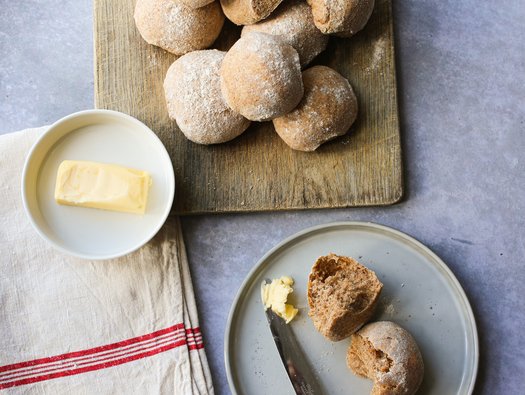Quick and easy wholemeal rolls

An easy to make wholemeal bread recipe that is low salt, high fibre and a good option as part of breakfast or lunch. The nutritional analysis is based on one bread roll.

An easy to make wholemeal bread recipe that is low salt, high fibre and a good option as part of breakfast or lunch. The nutritional analysis is based on one bread roll.
500g strong wholemeal flour
7g sachet fast-action yeast
3 tablespoons olive oil
300ml water
Extra flour for dusting
Mix the flour and yeast in a large bowl. Make a well in the centre, then add the olive oil and water and mix well. If the dough seems a little stiff, add 1-2 tablespoons of water and mix well again.
Tip the dough onto a lightly floured work surface and knead for around 10 minutes.
Once the dough is smooth, place it in a lightly oiled bowl and cover with cling film. Leave to rise for 1 hour until doubled in size or place in the fridge overnight.
Line a baking tray. Knock back the dough by pressing down to remove the air bubbles. With lightly floured hands, shape into 12 rolls and place on baking tray so the rolls are almost touching.
Leave to rise for 1 hour until they double in size again and dust with some extra flour. oven to 180°C / 160°C fan / gas mark 4.
Bake for 25-30 minutes until golden brown and they sound hollow when tapped underneath. Cool on a wire rack before serving.
The flour is the main source of carbohydrate in this recipe, and the value has been provided for those who have been trained in insulin adjustment.
Most breads are low in both potassium and phosphate, providing they are free of nuts, seeds and/or dried fruit. One of these rolls is low in both potassium and phosphate.
If you are following a low potassium and/or a low phosphate diet, then you should consider carefully what you serve with this bread. Avoid high potassium/phosphate fillings, toppings, or accompaniments. If you have also been prescribed with a phosphate binder, ensure you take them as directed.
Whilst this recipe is lower in salt and sugar, it is the equivalent to two slices of the average supermarket bread for potassium, phosphate and calories. Be mindful of how many rolls you have, as more than one may be too much.
Bread is generally a low protein food. If you have been advised to eat less protein, then choose a low protein accompaniment or limit the amount of protein you serve with the bread. If, however, you have been advised to eat more protein, then meat, fish, eggs, or a vegetarian/vegan alternative would make a suitable higher protein accompaniment.
Use gluten-free wholemeal flour.
This is a relatively healthy option as there is no added salt and using wholemeal flour increases the amount of fibre.
Once cooled, these rolls can be stored in an airtight container for up to 3 days. Alternatively, you could freeze for up to 3 months.
If you prefer you can make 1 large loaf for sliced bread. After step 3, mould into a large ball. Place it in a lightly oiled bowl and cover with cling film. Leave to rise for 1 hour until doubled in size, or place it in the fridge overnight. Dust with some extra flour and cut a cross about 6cm long into the top of the loaf with a knife. Bake for 25-30 minutes until golden brown. Cool on a wire rack before slicing into 12 slices.
By giving us your email address, you're giving us permission to send you the latest news from Kidney Care UK. Further information about how we protect and use your personal data is available in our Privacy policy. If you would like to change the way we communicate with you at any time please email [email protected]. You can unsubscribe at any time by using the link at the bottom of every email we send.